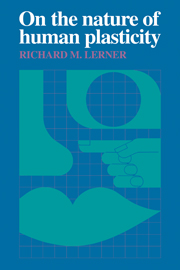Book contents
- Frontmatter
- Contents
- Foreword by Paul Baltes
- Preface
- 1 Perspectives on plasticity
- 2 The life-span view of human development: philosophical, historical, and substantive bases
- 3 Gene marking, recombinant DNA technology, and gene transfer: toward true gene therapy
- 4 Neuroanatomical bases of human plasticity
- 5 Human neurochemistry and the role of neurotransmitters
- 6 Evolutionary biology and hominid evolution
- 7 Comparative-developmental psychological bases of plasticity
- 8 Individual and group interdependencies
- 9 Toward future multidisciplinary efforts
- 10 Conclusions: On the limits of plasticity and the plasticity of limits
- References
- Author index
- Subject index
6 - Evolutionary biology and hominid evolution
Published online by Cambridge University Press: 22 March 2010
- Frontmatter
- Contents
- Foreword by Paul Baltes
- Preface
- 1 Perspectives on plasticity
- 2 The life-span view of human development: philosophical, historical, and substantive bases
- 3 Gene marking, recombinant DNA technology, and gene transfer: toward true gene therapy
- 4 Neuroanatomical bases of human plasticity
- 5 Human neurochemistry and the role of neurotransmitters
- 6 Evolutionary biology and hominid evolution
- 7 Comparative-developmental psychological bases of plasticity
- 8 Individual and group interdependencies
- 9 Toward future multidisciplinary efforts
- 10 Conclusions: On the limits of plasticity and the plasticity of limits
- References
- Author index
- Subject index
Summary
Several lines of evidence, derived from the literatures of evolutionary biology and anthropology, converge in suggesting that (1) features of human macroevolutionary change and of human microevolution provided a structural contribution to the unique degree of plasticity that characterizes humans' processes of development; (2) this evolution was both a basis of and derived from humans' behavioral, social, and cultural development; and (3) as a consequence, biological functioning and change – in regard to both ontogenetic and evolutionary progressions – are reciprocally related, first, to the social and cultural forces acting on the organism and, second, to the organism's own behavior as well. In this view, then, not only, for instance, did the evolution of the human brain enable humans to be socially responsive, but at the same time humans' social and cultural embeddedness were the key selection features for the human brain. In other words, human plasticity derives from an evolutionary synthesis between the human brain and human culture (Gould, 1977; Masters, 1978; Washburn, 1961).
Although work in support of these links has a long history, indeed dating back to at least the early nineteenth century, two lines of evidence will be presented. The first line of evidence derives from a recent, comprehensive scholarly integration of the literatures relevant to the concept of heterochrony (or differences in timing) in human evolution and development. This synthesis has been presented by Gould in his highly influential book Ontogeny and Phytogeny (1977).
- Type
- Chapter
- Information
- On the Nature of Human Plasticity , pp. 85 - 104Publisher: Cambridge University PressPrint publication year: 1984



